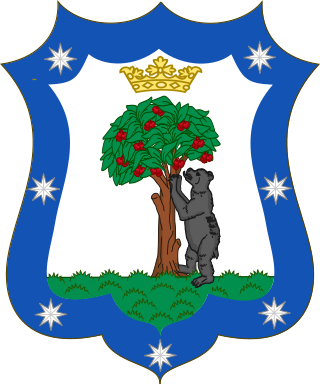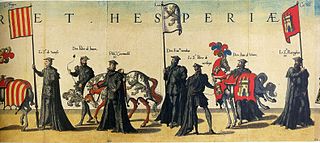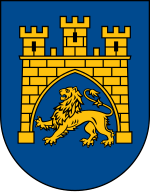In heraldry, gules is the tincture with the colour red. It is one of the class of five dark tinctures called "colours", the others being azure (blue), sable (black), vert (green) and purpure (purple).

The coat of arms of the Philippines features the eight-rayed sun of the Philippines with each ray representing the eight provinces which were placed under martial law by Governor-General Ramón Blanco Sr. during the Philippine Revolution, and the three five-pointed stars representing the three major island groups of Luzon, the Visayas, and Mindanao.

The coat of arms of England is the coat of arms historically used as arms of dominion by the monarchs of the Kingdom of England, and now used to symbolise England generally, but not officially. The arms were adopted c.1200 by the Plantagenet kings and continued to be used by successive English and British monarchs; they are currently quartered with the arms of Scotland and Ireland in the coat of arms of the United Kingdom. Historically they were also quartered with the arms of France, representing the English claim to the French throne, and Hanover.

The national flag of Ukraine consists of equally sized horizontal bands of blue and yellow.

The coat of arms of Bulgaria consists of a crowned golden lion rampant over a dark red shield; above the shield is the Bulgarian historical crown. The shield is supported by two crowned golden lions rampant; below the shield there is compartment in the shape of oak twigs and white bands with the national motto "Unity makes strength" inscribed on them.

The coat of arms of Lithuania is a mounted armoured knight holding a sword and shield, known as Vytis. Since the early 15th century, it has been Lithuania's official coat of arms and is one of the oldest European coats of arms. It is also known by other names in various languages, such as Waykimas, Pagaunė in the Lithuanian language or as Pogonia, Pogoń, Пагоня in the Polish, and Belarusian languages. Vytis is translatable as Chase, Pursuer, Knight or Horseman, similar to the Slavic vityaz. Historically – raitas senovės karžygys or in heraldry – raitas valdovas.

The coat of arms of Ukraine is a blue shield with a golden trident. It is colloquially known as the tryzub.

The coat of arms of Estonia is a golden shield which includes a picture of three left-facing blue lions with red tongues in the middle, with golden oak branches placed on both sides of the shield. The insignia derive(s) from the coat of arms of Denmark, which ruled northern Estonia in the 13th-14th centuries and parts of western Estonia in the 16th-17th century.

Mykolaiv is a city in Stryi Raion, Lviv Oblast (region) in western Ukraine. It hosts the administration of Mykolaiv urban hromada, one of the hromadas of Ukraine. The population is approximately 14,498.

The coat of arms of Luxembourg has its origins in the Middle Ages and was derived from the arms of the Duchy of Limburg, in modern-day Belgium and the Netherlands. In heraldic language, the arms are described as: Barry of ten Argent and Azure, a Lion rampant queue forchée Gules crowned, armed and langued Or.

The coat of arms of Montenegro was officially adopted by the law passed in the Parliament on 12 July 2004. It is now the central motif of the flag of Montenegro, as well as the coat of arms of the Armed Forces of Montenegro. It was constitutionally sanctioned by the Constitution proclaimed on 2 October 2007.

The coat of arms of Denmark has a lesser and a greater version.

The lion is a common charge in heraldry. It traditionally symbolises courage, nobility, royalty, strength, stateliness and valour, because historically the lion has been regarded as the "king of beasts". The lion also carries Judeo-Christian symbolism. The Lion of Judah stands in the coat of arms of Jerusalem. Similar-looking lions can be found elsewhere, such as in the coat of arms of the Swedish royal House of Bjelbo, from there in turn derived into the coat of arms of Finland, formerly belonging to Sweden.

The coat of arms of Bavaria has greater and lesser versions.

Coat of arms of Tallinn represents Tallinn, the capital city of Estonia.

The bear as heraldic charge is not as widely used as the lion, boar or other beasts.
A national coat of arms is a symbol which denotes an independent state in the form of a heraldic achievement. While a national flag is usually used by the population at large and is flown outside and on ships, a national coat of arms is normally considered a symbol of the government or the head of state personally and tends to be used in print, on armorial ware, and as a wall decoration in official buildings. The royal arms of a monarchy, which may be identical to the national arms, are sometimes described as arms of dominion or arms of sovereignty.

The first instance of a figure of the lion as symbol of the Kingdom of León is found in minted coins of Alfonso VII, called the Emperor (1126–1157). Until then, the cross had a preponderant position on documents and coins of Leonese monarchs since that reign the cross was gradually displaced by the lion. The Spanish historian and heraldist Martín de Riquer explained that the lion was already used as heraldic emblem in 1148. At the end of the reign of Alfonso VII, the figure of this animal began to appear on royal documents as personal device of the monarch and became pervasive during reigns of Ferdinand II (1157-1188) and Alfonso IX (1188-1230).

Heraldry is the system of visual identification of rank and pedigree which developed in the European High Middle Ages, closely associated with the courtly culture of chivalry, Latin Christianity, the Crusades, feudal aristocracy, and monarchy of the time. Heraldic tradition fully developed in the 13th century, and it flourished and developed further during the Late Middle Ages and the Early Modern period. Originally limited to nobility, heraldry is adopted by wealthy commoners in the Late Middle Ages. Specific traditions of Ecclesiastical heraldry also develop in the late medieval period. Coats of arms of noble families, often after their extinction, becomes attached to the territories they used to own, giving rise to municipal coats of arms by the 16th century.

The Ruthenian lion, Ukrainian lion, or Galicianlion is a golden lion on an azure background. The lion was featured on the historic coat of arms of the Kingdom of Galicia-Volhynia (Ruthenia), the Ruthenian Voivodeship and the Western Ukrainian People's Republic. During the revolutions in the Austrian Empire in 1848, it became one of the national symbols of Ukrainians and the Ukrainian national liberation movement. Today it is featured on the coat of arms of the city of Lviv and its surrounding province, Lviv Oblast.
























